It’s all over — EAA AirVenture Oshkosh, the world’s largest-attendance airshow event. It’s a delicious, if somewhat overwhelming, drink out of a firehose for an entire week.
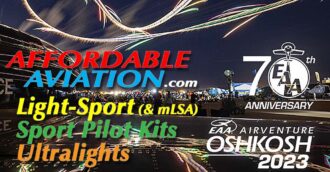 Oshkosh has something for every pilot and more than any one person can see.
Oshkosh has something for every pilot and more than any one person can see.
I’ll mention this news briefly as I wish to pay respect to fellow pilots. Two crashes on the weekend after we departed resulted in four fatalities reportedly including one passenger. My sincere condolences to the surviving families. Oshkosh has had safe years with no loss of life but when so many airplanes assemble, mathematical odds suggest a crash is going happen despite heroic efforts to make the event as safe as possible.
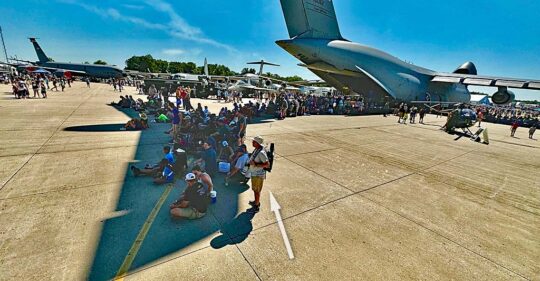
In the heat of Oshkosh 2023, people proved adept at finding shade where they could, in this case, that offered by a tailplane and fuselage… well, except for one fellow who was still enjoying the plentiful sunshine.
During the week of Oshkosh, a few days were rather warm. Cooling rains came mostly at night, sparing the airshow but surely soaking campers in tents. The campgrounds were full to the edges and EAA opened multiple other locations to handle the overflow. AirVenture’s campground metric — Camp Scholler handles 40,000 campers and that wasn’t enough — plus thick throngs of people to weave around anywhere I walked the show grounds suggested a great turnout to me. Indeed, EAA president Jack Pelton reported more than 677,000 visitors.
Mosaic and More
Given FAA’s earlier-than-predicted release of the highly-anticipated NPRM (Notice of Proposed Rule Making), Mosaic was on the minds of many aviators. The one thing that is no longer included is drones or multicopters. Once they were removed, the regulation went forward swiftly.
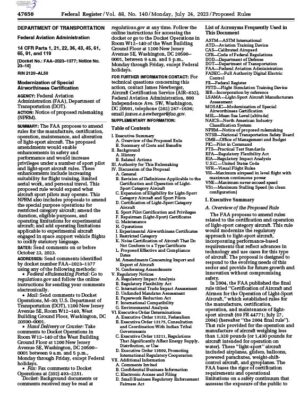
The Federal Register document was posted on Monday July 24, 2023. This is the official version you should use to comment. Click or tap the image to view the full document.
Mosaic burst upon the scene bearing unanticipated surprises. Through their proposal FAA has confirmed industry did well regulating itself. FAA has said repeatedly, “We want industry to do more.” ASTM’s F37 LSA committee members have clearly done an impressive job. Join ASTM here if you’d like to help!
In the video below I highlight several aspects of the new proposal but in the days and weeks ahead I will dive much more deeply into the NPRM. Various groups will closely examine the NPRM, producing summaries as soon as possible so you can digest the NPRM and compose your response. I hope each of you will let FAA know what you think, but write your own words. Scanning technology lets FAA group identical responses as one response, so say whatever you think but don’t copy and paste language others have proposed. Also, be polite and constructive; ranting will not help.
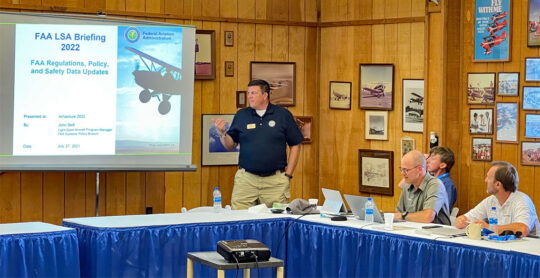
In FAA briefings like this one by LSA manager John Stoll last year, community leaders and manufacturers learn details.
The good news is that you don’t have to wait. I am quite impressed with nearly 200 comments to my earlier article. Some commenters have clearly dug into the details intensively.
Fly at Night? — Here’s one part of the NPRM that generated many comments. The question raised: “Can a Sport Pilot fly at night …without a medical.”
Commenter Rich wrote, “FAA stated at a forum yesterday [at Oshkosh 2023] that, yes, the intent is that for night flight a medical or BasicMed is required. The reason given was that they did not have enough trust in state driver agencies to adequately check eyes.”
I’m sure Rich heard and quoted the FAA guys correctly, however, reading the Federal Register release of Mosaic, I still believe the FAA will use endorsements to allow Sport Pilot certificate holders to receive training in pursuit of skills for night flying, retractable gear, adjustable props, and even IFR. The language in the NPRM supports this on page after page.
More Aircraft Coming
I know what most readers enjoy and fortunately I have the same interest. The following flying machines are ones I will be writing about in the days and weeks ahead. As with those aircraft already reported from the show, by no means are these all the intriguing aircraft at Oshkosh but they are ones I hope you will enjoy.
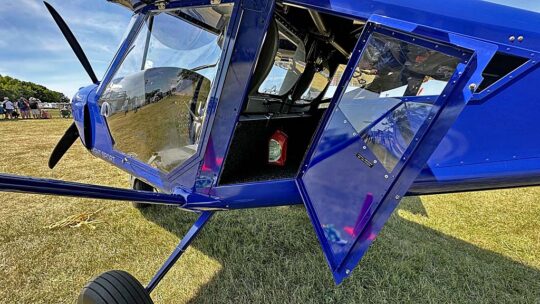
During AirVenture, former importer Dennis Long (who’s still helping) texted to say Aeroprakt had built their 1,500th aircraft. They aren’t just repeating though; they’re still innovating. One Aeroprakt on display had a third door (similar to Jabiru J-230D, Montaer MC-01, and KFA’s Safari XL). This makes loading baggage easier and allows use of the aft space in A-32 Vixxen’s roomy cockpit. New importer, Andy Humphrey, who operates as Heaven Bound, showed me another Aeroprakt at Oshkosh that was fully equipped for IFR, a use he noted is “permitted for Special LSA when used for IFR flight or recurrent training.” A standard in development by ASTM should allow flight into IMC that is not presently advised.
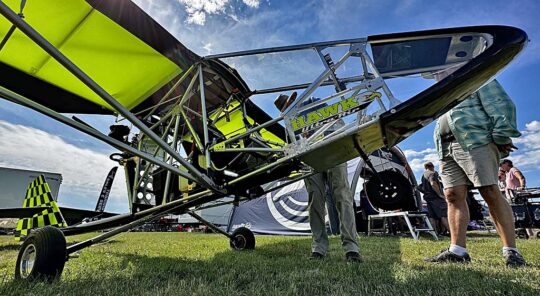
Bob Santom and son LB focus solely on the single place CGS Hawks including models that qualify for Part 103’s wonderful privileges. It turns out both CGS enterprises can stay busy. At AirVenture 2023, Bob and LB exhibited their open-cockpit Hawk Ultra Air. I thought it looked good with no Dacron skin covering the structure. I observed different pilots enter the cockpit — one weighing 165 pounds and one at 240 — and both seemed to fit easily. A 200-250 hour build for beginners, the display Hawk Ultra Air makes 103 with an airframe parachute, tipping the scales at a completely proper 278 pounds empty.
Read this article to learn more about Hawk as it celebrated 40 anniversary in 2022 (along with Part 103; botht came out in 1982).
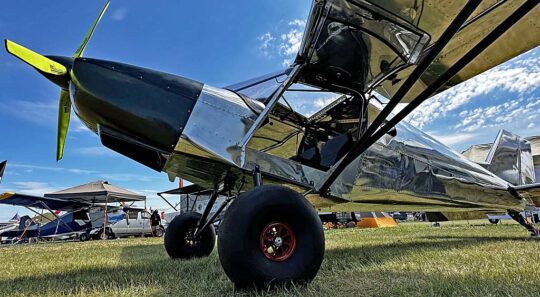
Mark Mellicker represented the G1 STOL at airshows for the last couple years (see this earlier article). As happens in aviation and any other business, events changed the organization and another company at AirVenture told me they were representing G1. So I had two clues when I saw Mark by this shiny new airplane. Mark decided to go on his own and, voila!, Aquilae.
When I write more about this, you will see it has a wing-fold system that many buyers like. It’s a large-ish, STOL-capable design like G1 but both G1 and Aquilae owe their design heritage to Alisport’s Yuma from Italy, though even that design signficantly resembles the Zenith 701, the granddaddy of such designs.
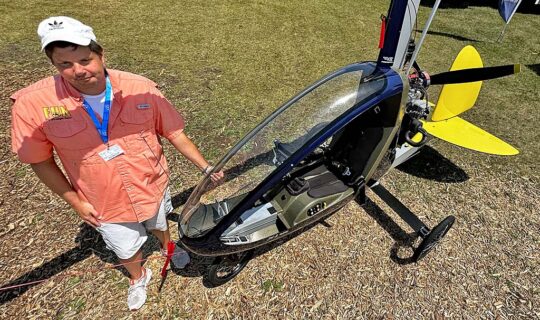
At AirVenture, Jeffrey of FUN, or Fly Ultralight Nano, showed an example propelled by a Hirth F23 engine producing 50 horsepower. He says it has behaved well for him and he’s actually had quite a success with this modestly-priced (less than $30,000) Part 103 aircraft. Big two seat gyros are fun and essential for training but once you know how to fly this type aircraft Nano might be the last aircraft you ever need.
I tried it on for size in 2021 and loved the way it felt and fit. Now with more substantial and dependable power I’d bet many more will arrive in the USA. However, it’s already been a good run as Fusion now has 35 flying around the world and Jonathan has lead the charge selling 21 units in the USA. That’s a performance of which he can be proud.
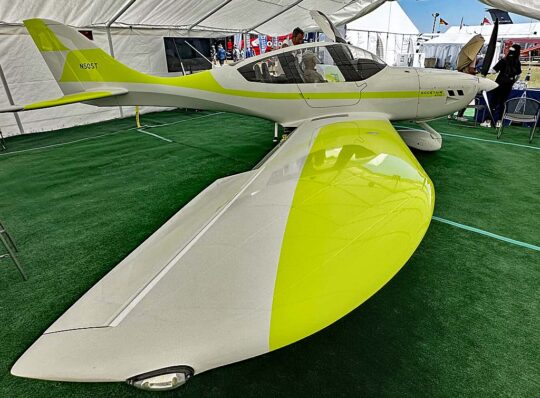
Shannon Hankins & Alan Jackson from Scissortail Aerosport, LLC are representing the G750 to North America. GoGetAir is a fairly new company, arriving on the scene during what might be called the Covid era. They started before but had to immediately survive that trying period with their handsome aircraft.
The timing of Scissortail and GoGetAir is marvelous, being right on the cusp of Mosaic being released. In the meantime, FAA has registration categories such Experimental Exhibition that allow import of a small number of fully-assembled aircraft to test the market. By late 2024 or early 2025, we should see Mosaic become official regulation and then G750 will easily fit the mLSA category assuming the company chooses to pursue and declare compliance with ASTM standards. Naturally, we have yet to learn how FAA will audit a new producer like GoGetAir although third-party audits have been discussed.
In case you didn’t notice the subtle suggestion in the photo, G750 is a four-seater, powered by the Rotax 915iS. This will be a very common combination when Mosaic officially arrives, but G750 also demonstrates style and a beautifully compound-curved leading and trailing edge wing.
All the preceding aircraft will get their own fuller treatment beyond this summary.
ARTICLE LINKS:
- Previous article written as Mosaic had first arrived; with almost 200 reader comments
- Proposed document in PDF form (318 pages)
- More recently released Federal Register document on Mosaic
- Same document as above, but in 3-column PDF format (may be the easiest to read/study; 90 pages)
- Link to EAA Radio, relating to the video below but offering lots more content
- Join ASTM if you wish to help with these standards; you will be welcomed
AIRCRAFT LINKS:
- Aeroprakt in the USA, at Heaven Bound
- CGS Hawk single seat aircraft
- Aquilae website
- FUN: Fly Ultralight Nano, including articles on this website
- GoGetAir in the USA; Scissortail Aerosport
In the following 12-minute video EAA Radio host J Mont G interviewed me about AirVenture 2023 — the aircraft, the anniversaries, Mosaic and more. I hope you’ll enjoy this lively give and take. Thanks to EAA Radio for permitting this video.



I remember hearing in your previous videos on MOSAIC that FAA “liked” manufacturers builders assist for experimental aircraft. Am I correct in remembering this? I read through the parts of the NPRM that seemed relevant to experimental aircraft but I saw nothing concrete referencing any changes that were in line with this. Did I miss something, misunderstand what I heard earlier, or is it absent from the NPRM? Thanks!
I have skimmed the entire NPRM but I did not deep study all portions, so I did not find separate verification yet. I searched the entire comment for “professional,” “build center,” and “assist” but found no reference to that earlier promise. FAA personnel mentioned several times that they planned to expand professional build centers yet I find no language to that effect.
If the FAA reason for night flying for Sport Pilots is the states Eye Sight standards or so, would a letter from an eye doctor stating the eye sight test results be good enough? Seems there will be more tendencies to “Get there” before dark and could cause more accidents rushing than arriving after sundown. If someone never has had a Medical then there is no way for night flying. Can’t get Basic Med without a previous medical.
It’s pretty clear to me that the language of the proposed rule makes it clear that FAA will require a third-class or Basic Med for night flight, and I’m hearing from people who are confused by this article. I think it should be clarified.
“”Proposed § 61.329(d) would also set forth certain medical requirements: the PIC must either hold a medical certificate issued under part 67, subpart D, Third-Class Airman Medical Certificate, or meet the requirements of § 61.23(c)(3) as long as the person holds a valid U.S. driver’s license.”
From 61.23(c)(3):
“(i) The person must—
“(B) At any point after July 14, 2006, have held a medical certificate issued under part 67 of this chapter;
“(D) Receive a comprehensive medical examination from a State-licensed physician during the 48 months before acting as pilot in command or serving as a required flightcrew member of an operation conducted under § 61.113(i) and that medical examination is conducted in accordance with the requirements in part 68 of this chapter; …”
I was at the ASTM F37 meeting on Wednesday. The FAA flight safety representative, Mark Giron, stated clearly and unambiguously that BasicMed or a 3rd class medical is required for night flying.
Other than the medical requirement, yes, night flying is only an endorsement.
The FAA also said something to the effect of “this endorsement may not be of any use to any existing Sport Pilots.”
However, they also stated they believed there were “plenty” of Sport Pilots, without a PPL that do have a medical.
I have not met one of these people.
Thanks for that added clarity. Mark Giron in Flight Standards is one of the people we spoke to numerous times. He would be a good resource on this matter, BUT pilots can still comment on this.
Attempting to “read the tea leaves”, and look at the document from a technical writing perspective, this requirement looks to be added very late in the process. That means it was likely a concession to Flight Standards to get Flight Standards to sign off on it.
As you correctly point out, most of the document makes no reference to additional medical requirements. (citation in 90 pg pdf):
“…sport pilot privileges through training and endorsements for airplanes…” (pg 6)
“…additional training and obtaining a flight instructor qualifying endorsement…” (pg 34)
“…sport pilot meets certain training, endorsement, and experience requirements.” (pg 34)
“…certain training and experience requirements and by obtaining an endorsement…” (pg 34)
The only discussion passage mentioning the medical requirement:
“Proposed § 61.329(d) would also set forth certain medical requirements…” (pg 35)
The only other mention is in the actual changes to add § 61.329(d) on page 85.
To “bury the lede” of a new requirement for a medical is sloppy at best, if not intentionally misleading.
I would wonder it this is also a potential legal issue, if the FAA is exceeding their statutory authority by either restricting Sport Pilot in a manner NOT allowed by statute, or by effectively creating a “Super Sport Pilot” license, without the authority to do so.
I’m not sure exactly how it works if there are lots of comments on something that one department insisted on.
I worry that Flight Standards can simply say “We believe this enhances safety, and therefore find the comment unpersuasive.”
You understood my point well, Steve. This topic appears to show some inconsistency in language… but that is the purpose of a proposal (rather than a final ruling issued without public comment). If enough people comment on this, it should be clarified in the final version.
It is also worth noting that this medical requirement seems to be unique in the entire proposal in being presented without any explanation or justification.
The proposal does not even include a statement as simple as “we believe this medical requirement is justified and will increase safety”. In contrast, the proposal provides extensive justification that night privileges can enhance safety.
I am not familiar with how strictly the comments have to be evaluated, but it would seem in the absence of any justification **FOR** the requirement; **ANY** reason against the requirement would win over.
There is also no mention of any additional medial requirements in any of the “Regulatory Impact Analysis”. That seems like a problem as well.
Excellent points. Some additional clarification seems necessary.
Dan,
Is there a link for FAA NPRM comments ? Also; why does the new rule reference
KCAS ? All I know is what I see and what I see on the airspeed indicator is KIAS.
The new rule should use terms that are more usefull.
Thanks,
Frank
KCAS is simply calibrated KIAS and generally means 1 or 2 knots of difference, if that, due to pitot tube placement or aircraft attitude error (example: speed with and without flaps may read slightly differently because the aircraft’s attitude changed). KIAS readings are usually shown with a calibration correction but essentially the two are close. A key reason to want numbers precise to a single digit is to assure compliance with the 54 knot clean stall requirement.
As to sending FAA your comments, here is what the Federal Register says:
“Send comments on or before October 23, 2023.
“Send comments identified by docket number FAA–2023–1377 using any of the following methods:
• Federal eRulemaking Portal: Go to Regulations.gov and follow the online instructions for sending your comments electronically.
• Mail: Send comments to Docket Operations, M–30; U.S. Department of Transportation (DOT), 1200 New Jersey Avenue SE, Room W12–140, West Building Ground Floor, Washington, DC 20590–0001.”
I have inquired about a more specific comment link but others have figured this out.
Dan,
Thanks for getting back to me so soon. I appreciate that the FAA would
want to be precise down to a single digit. Why not make it precise
down to a single digit using KIAS. Here is the thing; KCAS is in effect,
more restrictive. As I understand it; C-182 Vs1 for many models is 54Kts KIAS; it follows that KCAS would likely be a higher value and
many models of C-182 would be outside the new rule. I believe; the
current Textron C-182 KCAS Vs1 is within 54Kts; which is curious. I believe you indicated in a prior post that the pilot must demonstrate compliance. So the average sport pilot is to work a table or graph; that is, if the conversion is even in the manual, when ramp checked by the FAA. For decades I have studied aircraft manuals as thick as phone books and have never seen KCAS mentioned so many times as the new rule.The new rule should remove reference to KCAS and put KIAS in its place.
Just sayin.
The key thing to remember here is the FAA cares more about **how fast the plane is actually moving** rather than whatever the instruments show.
The 2010 revision of the C-182T lists the Vs1 as 54 KCAS (pg iv)
The airspeed limitation list both KIAS and KCAS (pg 2-4)
The airspeed indicator markings only list KIAS, but that is describing the airspeed indicator.
The 1978 C-182Q lists Vs1 as 56 KCAS.
This is also an evaluation that is made against the POH, not while flying.
Were they to use KIAS, a manufacturer could simply have a very poorly mounted pitot with a huge calibration error.
A more reasonable value would be TAS at sea level in standard conditions, but that is harder for a manufacturer to measure.
It is great to see Dan so excited about Mosaic . I (and many others) appreciate the hard work that he and others did to “set the table” for FAA to use as some of the guidelines they may have chosen to work with. Many comments will be submitted to the proposal , but I for one, would be happy to have it go into law AS IS.